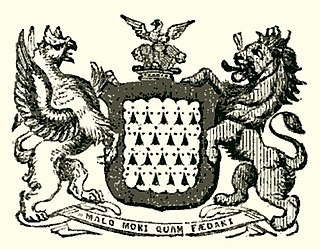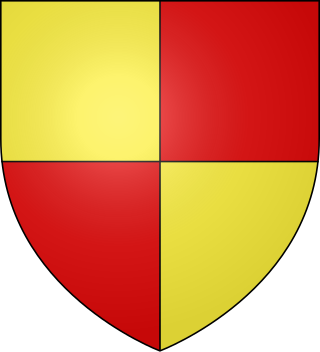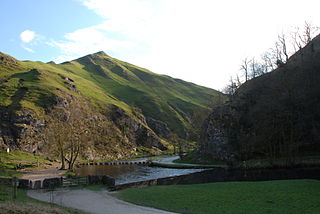Related Research Articles
The Lord High Chancellor of Ireland was the highest judicial office in Ireland until the establishment of the Irish Free State in 1922. From 1721 to 1801, it was also the highest political office of the Irish Parliament: the Chancellor was Speaker of the Irish House of Lords. The Lord Chancellor was also Lord Keeper of the Great Seal of Ireland. In all three respects, the office mirrored the Lord High Chancellor of Great Britain.

Rowland FitzEustace, 1st Baron Portlester was an Irish peer, statesman and judge. He was one of the dominant political figures in late fifteenth-century Ireland, rivalled in influence probably only by his son-in-law Garret FitzGerald, the "Great" Earl of Kildare.

John Barnewall, 3rd Baron Trimleston, was an Irish nobleman, judge and politician. He was the eldest son of Christopher Barnewall, 2nd Baron Trimlestown and his wife Elizabeth Plunket, daughter of Sir Thomas Fitz-Christopher Plunket of Rathmore, Lord Chief Justice of the King's Bench in Ireland and his second wife Marian Cruise. He succeeded his father as 3rd Baron in about 1513. His father, like most of the Anglo-Irish aristocracy, had supported the claim of the pretender Lambert Simnel to the English throne in 1487. After the failure of Simnel's rebellion, he received a royal pardon.

The Chief Baron of the Irish Exchequer was the Baron (judge) who presided over the Irish Court of Exchequer. This was a mirror of the equivalent court in England, and was one of the four courts which sat in the building in Dublin which is still called The Four Courts.

Sir Richard FitzEustace (c.1380–1445) was an Irish statesman who twice held the office of Lord Chancellor of Ireland.
Sir Robert FitzEustace (c.1420–1486) was an Irish landowner and politician of the fifteenth century.
Sir Robert Dowdall was an Irish judge who held the office of Chief Justice of the Irish Common Pleas for more than forty years. He is mainly remembered today for the murderous assault on him by Sir James Keating, the Prior of Kilmainham, in 1462.
James Cornwalsh was an Irish judge who held the office of Chief Baron of the Irish Exchequer. He was a political figure of considerable importance in fifteenth-century Ireland, and a supporter of the Lord Lieutenant of Ireland, James Butler, 4th Earl of Ormond. He was murdered as a result of a feud over the possession of Baggotrath Castle, near Dublin.
Henry Burnell was an Irish judge and politician; he served briefly as Recorder of Dublin and as a justice of the Court of King's Bench. Though he was willing to accept Crown office, he spent much of his career in opposition to the Government. He was one of the leaders of the protest against the policies of the Lord Deputy of Ireland Sir Henry Sidney in the late 1570s, and as a member of the Irish House of Commons in the 1580s he successfully opposed Sidney's successor, Sir John Perrot. In the early 1600s, he was one of the leaders of the protest against strict enforcement of the Penal Laws. His professional reputation was gravely damaged in his later years by a verdict that he was guilty of forgery, when he was convicted and fined for having altered a deed concerning the inheritance of the 11th Earl of Kildare's estate. He was the grandfather of the playwright Henry Burnell.
Robert de Holywood was an Irish judge and landowner who held the office of Chief Baron of the Irish Exchequer. He was the ancestor of the Holywood family of Artane Castle, and of the St. Lawrence family, Earls of Howth. He was a substantial landowner with property in Dublin, Meath and Louth. He became extremely unpopular, and was removed from office after numerous complaints of "oppression and extortion" were made against him. These were apparently inspired ĺargely by his close association in the mid-1370s with Sir William de Windsor, the embattled Lord Lieutenant of Ireland.
Clement Fitzleones, FitzLyons, or Leones was an Irish lawyer and judge. He held the offices of Serjeant-at-law (Ireland) and Attorney-General for Ireland and was briefly Deputy to the Chief Baron of the Irish Exchequer.
Oliver FitzEustace was an Irish judge. His appointment as Chief Baron of the Irish Exchequer was a surprising one since according to the leading historian of the Irish judiciary he appears to have been unable to speak.
John Estrete, or Strete was an Irish judge, author, law lecturer and statesman of the late fifteenth century. He held the offices of King's Serjeant, Deputy Chief Baron of the Irish Exchequer, and Master of the Coinage of Ireland. He was a member of the Privy Council of Ireland. He wrote at least one legal textbook, Natura Brevium.
The Burnell family were a Dublin family who were prominent in Irish public life and in the arts from the thirteenth to the seventeenth century. They acquired substantial estates in County Dublin, and married into the Anglo-Irish aristocracy. They produced several judges and politicians, a leading playwright, and one of the first female Irish poets. They were staunch Roman Catholics, who opposed the Penal Laws, and supported the Irish Confederacy in the 1640s. They forfeited most of their lands after the failure of the Confederate cause, and never recovered them.

Nicholas Sutton was an Irish judge of the fifteenth century, who held the offices of Attorney General for Ireland and Baron of the Court of Exchequer (Ireland). His career demonstrates how small the Irish legal world was at the time: his father held the same two offices, while his widow married his successor as Baron of the Court of Exchequer. His will, which no longer exists, has been described as being full of "curious details".
Richard Talbot (c.1520–1577) was a sixteenth-century Irish judge and landowner. He is notable as the ancestor of the prominent Talbot family of Mount Talbot, Dublin, and for his lawsuit against Nicholas Nugent, the future Chief Justice of the Irish Common Pleas.
John Tirel, or Tyrell was a prominent judge and statesman in fourteenth-century Ireland who held office as Serjeant-at-law and Chief Justice of the Irish Common Pleas.

Thomas Dowdall, also spelt Dowdale, Douedall, or Dowedall, was an Irish barrister and judge who held the office of Master of the Rolls in Ireland.
Thomas Archbold, or Thomas Galmole was a goldsmith and silversmith, who also qualified as a lawyer, and rose to become a senior Crown official and judge in Ireland in the late fifteenth and early sixteenth centuries. He was Master of the Mint in Ireland for many years.
Patrick Burnell was an Irish judge and Crown official of the fifteenth century.